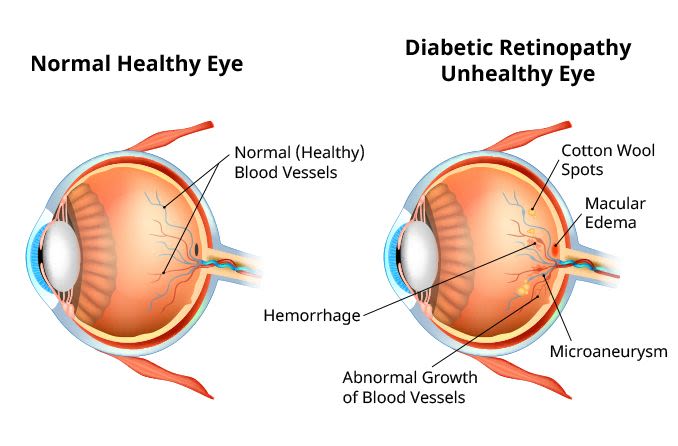Eye disease in African American communities
Over 190,000 African Americans have low vision, according to the National Eye Institute. And data show that Black communities may have a higher risk of developing some eye diseases that can lead to vision loss.
One thing to keep in mind: Statistics don't necessarily mean any individual patient is at higher risk for a certain eye condition, says Dr. Tiffany Humes, an optometrist practicing in Detroit, Michigan, the city with the largest Black population in America.
"In some cases, ethnicity or race may be a risk factor, but that doesn't mean all African Americans are at risk," Dr. Humes says.
Here's a list of eye conditions that may disproportionately affect African Americans, and the steps you can take to lower your risk and keep your eyes healthy:
Cataracts
Cataracts are a common cause of cloudy or hazy vision in older patients. They develop when the protein in the natural lens of the eye begins to break down and form clumps.
Symptoms of cataracts may include blurry vision, double vision, and problems with color vision and night vision.
An eye doctor may see cataracts beginning to form before a patient notices issues with their vision. When a patient’s vision is affected, they can be treated with cataract surgery to replace the clouded lens of the eye with a clear artificial lens (called an intraocular lens or IOL).
Statistics on African Americans and cataracts
- Among African Americans, cataracts are the top cause of vision loss overall, and also the leading cause of blindness.
- Research shows that African Americans are four times more likely to develop cortical cataracts, opacity in the outer layer of the lens of the eye. Cortical cataracts are more common in patients with conditions such as diabetes and high blood pressure.
- African Americans are less likely than Caucasians to develop nuclear cataracts, in which the center of the lens of the eye gets cloudy and hard.
- African Americans are less likely to have cataract surgery than Caucasians. And African Americans who have cataract surgery have a higher risk for a type of uveitis, inflammation in the middle layer of the eye, after surgery.
Risk factors for cataracts
Most people who develop cataracts are 40 or older. A variety of factors, including being African American or Latino American, may increase your chances of developing cataracts at an earlier age. Other cataract risk factors include:
- Use of certain medications (such as corticosteroids and statins for cholesterol)
- Diabetes
- Eye injury, surgery or radiation treatments in the past
- Having close relatives with cataracts
- Heavy alcohol consumption
- High blood pressure
- History of eye inflammation
- Hormone replacement therapy (HRT)
- Obesity
- Severe nearsightedness (high myopia)
- Smoking
- Spending a lot of time outside in the sun without sunglasses
How to reduce your risk of cataracts
There is no way to stop cataracts from developing. But here are steps you can take that may postpone or slow the development of cataracts:
- Eat a healthy diet and get regular exercise
- Get regular eye exams
- If you're a smoker, make a plan to kick the habit
- Wear sunglasses with 100% UV protection
- Use floppy hats as well to protect your face from the sun
- Visit your doctor regularly and keep other conditions under control (diabetes, hypertension)
If you get diagnosed with cataracts early, your eye doctor will be able to offer treatment options that may help to improve your vision and can advise you on when surgery may be your best option.
Diabetic retinopathy
About 10% of the U.S. population has diabetes, a chronic condition that affects your blood sugar levels. Diabetes can cause problems throughout the body, including in the eyes.
Diabetic retinopathy (DR) is one of the eye diseases caused by diabetes. High blood sugar from diabetes can cause blood vessels to leak, causing swelling in parts of the eyes. Over time, scar tissue and abnormal new blood vessels may form.
Due to these changes, DR can lead to the loss of front and peripheral (side) vision, along with other eye problems such as retinal detachment. This is an eye emergency because it can cause blindness without fast treatment.
For patients who have diabetic retinopathy, an eye doctor may prescribe eye injections of medications that can slow vision loss or make vision better.
Statistics on African Americans and diabetic retinopathy
- Diabetes affects about 11.7% of non-Hispanic Black Americans, compared with 7.5% of non-Hispanic white Americans and 12.5% of Hispanic Americans, according to the American Diabetes Association.
- More than 850,000 African Americans have diabetic retinopathy, according to the National Eye Institute.
Risk factors for diabetic retinopathy
Various factors, such as long-term and uncontrolled diabetes, can increase your risk for diabetic retinopathy.
In addition to being African American, Latino American or Native American, risk factors for diabetic retinopathy include:
- Fluctuating blood sugar levels
- Having had diabetes for 10 years or more
- High cholesterol
- Diabetes during pregnancy (gestational diabetes)
- Smoking
- Uncontrolled high blood pressure (hypertension)
How to reduce your risk of diabetic retinopathy
Here are steps you can take to lower your risk of diabetic retinopathy or, if you already have the condition, to keep your eyes as healthy as possible:
- Get a diabetic eye exam as often as recommended by your eye doctor
- Follow your doctor's advice to control diabetes with diet and medication
- If you have diabetic retinopathy, follow your eye doctor's treatment plan
When patients have diabetes, it's important for their eye care provider, primary care doctor and specialists to communicate and work together as a team to maintain overall wellness and eye health, says Dr. Darryl Glover, an optometrist in Durham, North Carolina.
Glaucoma
Glaucoma is a group of eye conditions typically caused by too much pressure in one or both eyes. Over time, the increased pressure can damage your optic nerves, which carry signals between the eyes and the brain.
Glaucoma can lead to vision loss or blindness, and, while glaucoma itself cannot be prevented, its effects on vision can be slowed or limited with early diagnosis and treatment.
Statistics on African Americans and glaucoma
- There is a higher prevalence of glaucoma in African Americans than in Caucasians. Glaucoma is about five times more common in African Americans, and blindness from glaucoma is six times more common.
- Glaucoma occurs about 10 years earlier on average in African Americans than in other populations.
- For African Americans with a family history of glaucoma, the risk of developing the eye disease goes up by 20%.
- The cause of increased glaucoma risk for African Americans isn't fully understood. However, African Americans may tend to have thinner corneas, which is a risk factor.
Risk factors for glaucoma
African American and Hispanic patients are at a higher risk for developing glaucoma than non-Hispanic white patients. Other risk factors for glaucoma include:
- Age (40 and up for African Americans)
- Family history of glaucoma
- Increased eye pressure
- Diabetes or high blood pressure
- History of eye injury, trauma or surgery
- Long-term use of some medications such as steroids
- Thin corneas, the clear dome-shaped outer layer of the eyes that provides most of their focusing power
If you have one or more glaucoma risk factors, your eye doctor may classify you as a glaucoma suspect. This does not mean you have glaucoma or that you are guaranteed to get it. However, your doctor may want to see you more frequently to track changes in your vision and eye health.
This type of monitoring makes it possible for your doctor to spot early indicators, make diagnosis and start treatment as soon as possible, all of which may help lower your chances of losing your vision.
How to reduce your risk of glaucoma-related vision loss
Here are steps you can take to either lower your risk of developing glaucoma or prevent vision loss caused by glaucoma:
- Get a dilated eye exam with glaucoma testing as often as your eye doctor recommends (at least every one to two years)
- Talk to your eye doctor about moderate exercise for glaucoma prevention
- Take glaucoma eye drops as prescribed by your eye doctor to treat elevated eye pressure or the condition as a whole
- Consider laser treatment or glaucoma surgery if recommended by your eye doctor
A healthy lifestyle and regular eye exams may help prevent or delay glaucoma-related vision loss. If you've already been diagnosed with glaucoma, following your treatment plan can help you avoid further visual deterioration.
Autoimmune conditions that can affect the eyes
There are also a variety of autoimmune conditions that may affect the eyes, says Dr. Jacobi Cleaver, optometrist and director of program management for BlackEyeCare Perspective, including:
- Eczema
- Lupus
- Rheumatoid arthritis
Each of these conditions may affect the eyes in different ways, but inflammatory dry eye is common in patients with many different autoimmune conditions, Dr. Humes says.
Eczema
Eczema is an inflammatory condition that can cause itching, redness, blisters and skin infections. It affects over 31 million Americans (a little over 10% of the U.S. population). While African Americans have a slightly lower prevalence of eczema in general, they may be more likely to have severe eczema.
Risk factors to the eyes: Patients with more severe eczema have a higher risk of eye problems, which can include conjunctivitis (pink eye), inflammation of the cornea (keratitis) and keratoconus, a condition in which the front of the eye bulges due to a thinning cornea.
Lupus
Lupus is an autoimmune disease that can cause inflammation in the skin, joints and other parts of the body. It affects 1.5 million Americans, 90% of which are women. Lupus is two to three times more common in African American women than in white women, and one in 537 young African American women have lupus.
Risk factors to the eyes: Effects of lupus on the eyes may include dry eyes, optic nerve damage, rashes around the eyelids, scleritis and diseases of the retina (a membrane on the inner surface of the back of the eyeball that is key to good vision).
Rheumatoid arthritis (RA)
Rheumatoid arthritis (RA) is a painful autoimmune disease that typically affects the joints. Recent research shows that rheumatoid arthritis may be more prevalent in non-Hispanic African American communities, but more studies are needed in this area.
Risk factors to the eyes: There are a number of eye problems linked to rheumatoid arthritis. For example, RA may lead to dry eye syndrome, uveitis (an inflammation of the middle part of the eye) and scleritis (an inflammation in the whites of the eyes). Rheumatoid arthritis can also increase a person’s risk of developing glaucoma and lead to developing cataracts at a younger age.
Let your eye doctor if you have an autoimmune disease so they can monitor your eyes for any related changes to your vision or eye health. They will also look out for side effects of any medication you may be taking, Dr. Cleaver says.
Tips for keeping your eyes healthy
Focusing on eye health and practicing overall healthy behaviors like eating well and exercising can help keep your eyes healthy. Here are some tips for keeping your eyes happy:
- Get regular eye exams – Early diagnosis allows your eye doctor to treat eye disease quickly and potentially slow or limit your chances of vision loss. Get a comprehensive eye exam once a year unless your eye doctor has told you to get one more often. "Everyone should get an eye exam every year," Dr. Glover says. "That will facilitate eye care for all patients."
- Live a healthy lifestyle – Eat an eye-healthy diet that includes beans and legumes, fish, orange and yellow fruits and vegetables, as well as leafy greens. If you smoke, make a plan to quit. And try to get about 30 minutes of exercise a day for five days each week. Research shows that regular, moderate exercise may help prevent or manage glaucoma, diabetic retinopathy and macular degeneration.
- Protect your eyes from the sun – Wear sunglasses with 100% UV protection whenever you spend time outside. Protecting your eyes from the sun's rays can help prevent or delay cataracts, macular degeneration and other eye problems.
- Keep any health conditions under control – If you have a chronic condition such as diabetes, working with your doctor to keep it under control is one of the most important steps to take, Dr. Humes says.
And finally, make sure to see your eye doctor right away if you experience any major vision changes or eye-related symptoms. If you’re at risk for developing a sight-threatening eye condition, early diagnosis and treatment may be key to saving your vision.
READ NEXT: National Optometric Association (NOA)







